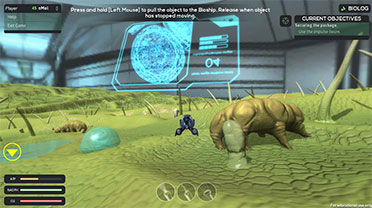Meta!Blast
(in development)

The Iowa State University developers of Meta!Blast may claim that the game “is a unique approach to an educational challenge” but it is actually cookie cutter similar to Immune Attack. You pilot a microscopic ship in an organic 3D environment, only this time it is a dying soybean plant rather than a defective immune system that needs to be patched up. And just like Immune Attack, scanning organisms, cells and organelles will produce an information box with text and pictures for your learning.
You begin exploring the surface of a leaf, then the leaf interior, a cell, a chloroplast, and the nucleus. Everything looks very appealing but like most games (not only educational ones) Meta!Blast’s environment are more akin to a film set than reality. Your journey feels like a guided tour through a virtual museum. There is little interaction between you and the environment, no interaction between objects in the environment, and no real freedom – for example, when you are instructed to bring water to a dehydrated tardigrade you must pick up the water in the specific spot the game points out for you even though there is water to be found all around on the leaf.
Still, taken as a purely visual 3D representation of a photosynthetic cell Dr. Eve Syrkin Wurtele and her huge team of students from departments of Art and Design, Biology, and Computer Science and Human Computer Interaction have done fine. Maybe they will in time also manage to breathe some life into the prop mitochondria and prop chloroplasts of the game, which has been in development since 2008.
The laughable claims that the game “encourages creative, non-linear thinking by engaging students in problem-solving via game play, role enactment.” is political speak not to be taken seriously by anyone with half a brain.
Ola Hansson, 15 October 2014

